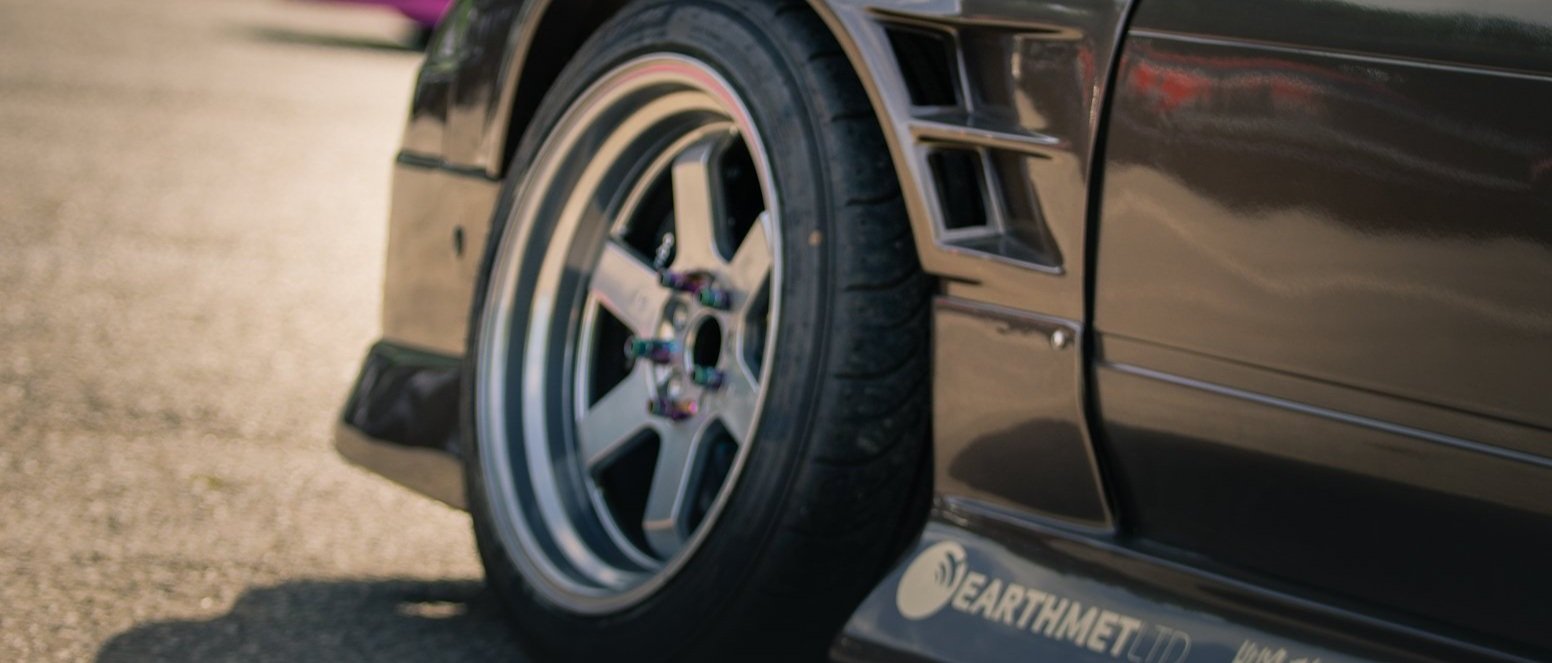Tech Talk: Wheels and Tyres
Let’s tackle the sticky subject of wheels and tyres — this can be a bit of a minefield, and if you look at ten different Formula G cars you’ll see ten different approaches! From stock wheels and road tyres, to super-wide wheels and massive stretch with semi-slicks, finding what works for you and your car can be a process. So we’re here to help!
There’s quite a lot more to tyres than just diameter! Here are some considerations to take in to account when selecting your wheel/tyre combination:
Rolling circumference — the overall circumference of the tyre affects acceleration and top speed (and ground clearance but hopefully you’ve got adjustable shocks on a well set up track car). Your best bet is to start with something similar to what the manufacturer recommends. Smaller circumference setups will give better acceleration but lower top speed, and generally less unsprung weight. Larger circumference setups will give a higher top speed, less acceleration and potentially higher unsprung weight. If your gears don’t exactly suit what you’re doing, you can, to an extent, work around it by varying the circumference — use one of the many gear calculators online to help you understand the impact of each change.
Tyre width — wider tyres will offer more grip naturally, but will also make the setup heavier. Narrower setups will feel more lively because of the lower weight and grip. How much tyre you want on the road will be determined by how much you can fit under the arches, how much power you have, and driving style and personal preference. How a tyre feels can also be altered by the width of the wheel, see below.
Tyre profile — this is the height of the tyre, measured as a percentage of the width of the tyre. A 45 profile tyre with 225 width will be about 18mm shorter overall than a 45 profile tyre with 245 width. Sidewall stiffness varies from tyre to tyre, so do some research when selecting them, but all else being equal a taller sidewall will result in more tyre roll and vice versa. A bit of tyre roll can make the car feel a bit more predictable, whereas lower profile tyres can break away quickly. Depending on how you prefer your car to feel, to achieve your desired rolling circumference you may want a shorter tyre on a bigger rim or a taller tyre on a smaller rim.
Wheel diameter — to be considered when determining your overall rolling circumference and desired tyre profile. You also need to consider whether you can fit the wheels over your brake setup, present or future. There would be little point in getting 15s when the mega 8 pot big brake kit you have your eye on for next winter’s upgrade won’t fit underneath them!
Wheel width — how wide a wheel you want will depend on the width of the tyre desired, the cross-sectional shape of the tyre desired, how much you can fit in your arches, and weight considerations. Having a narrow tyre on a wide wheel introduces ‘stretch’ – too much stretch and your tyres just won’t work as intended, but a little stretch can artificially stiffen up the sidewalls. Or, for slightly more tyre roll for a given profile and potentially more progressive feel, go for a tyre and wheel of a similar width. We’ll leave offset and scrub radius for now, that’s a whole other rabbit hole…
Now the above theory is all well and good but you can’t always get the tyre you want in the theoretical size you need. Not all brands make every conceivable variation of tyre size, so do a little research and see what you can get your hands on.
In terms of tyre selection, Formula G allows you to run whatever rubber you like, as long as it’s road legal. There is a huge range of performance tyres out there, and we won’t go in to the merits and drawbacks of each one, but we can tell you that you’ll want more grip than you think. While it may be true that it is harder to get a car to rotate on very grippy tyres, there’s no point rotating quickly if you can’t then hook it up and get to the next obstacle! One also needs to bear in mind that there is no tyre warming like there is in drifting or drag racing, so you’ll want a compound that gives you decent grip from cold. The runs are fairly short, too, so you’d want to avoid a tyre that takes too long to get to operating temperature.
Once you’ve decided on your wheel and tyre combo, the final thing to consider is the overall weight of the setup. It’s An important consideration, as it can really affect how your car feels. Lighter wheels feel more lively and accelerate better, whereas a heavy combo can make the car feel more sluggish. Do your research to find out whether a larger wheel and smaller tyre works out lighter than a smaller wheel and larger tyre. It’s not always the way round you think it will be!
Throughout all of this agonising you’ll also need to be conscious of your budget — as always it comes down to what you can afford. Larger diameter wheels often mean more expensive tyres, lightweight setups can also be pricey. However, do not compromise on performance for the sake of saving for your ideal setup for just a little longer – it’ll be worth it I promise!
There’s a lot to take in to account, and to make things easier I use www.willtheyfit.com to calculate the numbers and make comparisons between two setups. Unfortunately there aren’t many try before you buy options out there so beg borrow or steal your mates’ setups to try before committing to anything if you can! There’s no magic bullet unfortunately, and you may need to make compromises if the perfect setup doesn’t exist, but experimenting is half the fun sometimes — just keep in mind that shaving a tenth off your time can be the difference between winning and losing!
If you would like any advice on your setup from the Formula G drivers themselves, or chat about things not covered here such as air pressures, head on over to Competitors Corner on Facebook and ask away!





